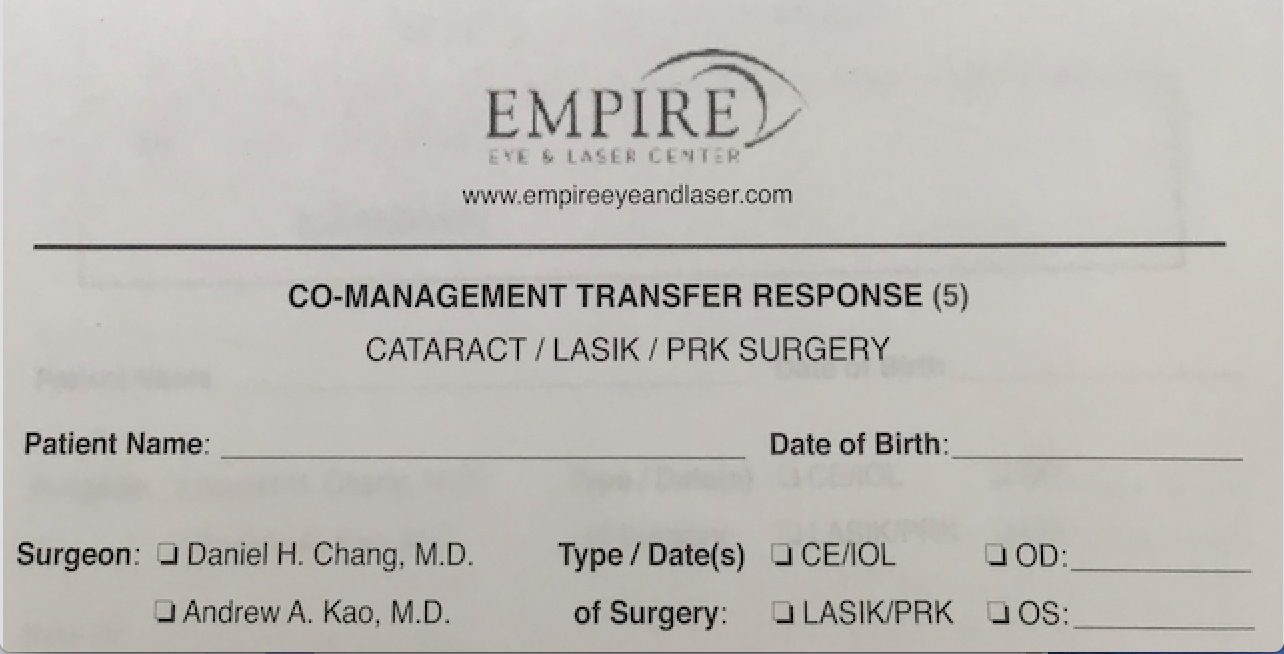Article
Five secrets to success with co-management
Author(s):
Five ophthalmologists share how to make the most of a co-managed relationship for smoother patient handoff, improved preoperative experiences, and better postoperative outcomes.
Editor’s Note: Welcome to “Eye Catching: Let's Chat,” a blog series featuring contributions from members of the ophthalmic community. These blogs are an opportunity for ophthalmic bloggers to engage with readers with about a topic that is top of mind, whether it is practice management, experiences with patients, the industry, medicine in general, or healthcare reform. The views expressed in these blogs are those of their respective contributors and do not represent the views of Ophthalmology Times or UBM Medica.
In this collaborative blog post, learn how building rapport and sharing like-minded philosophies benefits your practice and your patients. Five ophthalmologists share how to make the most of a co-managed relationship for smoother patient handoff, improved preoperative experiences, and better postoperative outcomes.

Image courtesy of TearScience

1. Do what is best for the patient

Dr. Donnenfeld“The most important aspect of co-management is that both parties collaborate in providing the best possible care for the patient,” said Eric Donnenfeld, MD, who practices with Ophthalmic Consultants of Long Island and Connecticut, and is clinical professor of ophthalmology, New York University.
One of the ways this plays out in his practice is making sure patients arrive ready for surgery.
“We have emphasized to our optometric network the importance of managing the ocular surface in patients coming in for cataract and refractive surgery,” he said.
Previously, if patients arrived for a surgical evaluation but their ocular surface was not optimized, clinicians had to defer surgery. Now, the optometric network manages ocular surface disease before referring patients.
“The patient comes in and has already been treated appropriately, whether it be with an immunomodulator, a steroid, omega-3 supplements, or LipiFlow thermal pulsation,” he said. “It is so helpful when the patient comes in for a cataract or LASIK evaluation with the best ocular surface possible.”
Dr. Donnenfeld noted the importance of the optometrist’s recommendations.
“A doctor who has been taking care of that patient for a decade is going to know a lot more about that patient’s personality, history, and vision care experiences than I can learn in a short consultation, so their counsel becomes very important in my decision as to what lens the patient should receive,” he said.



2. Look for partners who share your philosophy

Dr. KontosWhen building a successful co-management network, ophthalmology practices should seek out and nurture relationships with like-minded partners.
“We look for optometrists who are progressive, engaged in continuing education, and who are always looking to learn more about what is happening in eye care,” said Mark Kontos, MD, who is in private practice with Empire Eye Physicians, Spokane, WA, and Coeur d'Alene, ID. The practice has co-management relationships with about 75 optometrists.
“A fundamental theme in our practice is that we want to be on the cutting edge of innovation in ophthalmology,” Dr. Kontos said.
For example, his practice likes to use advanced technology lenses to correct astigmatism and presbyopia, but that can be a source of conflict if the referring optometrist has little interest in or knowledge about the technology.
“We feel that new lenses like the extended-depth-of-focus IOLs [Tecnis Symfony, Johnson & Johnson Vision] are beneficial to patients, and so it is important that we are on the same page with our referring doctors,” he said.
To keep co-management partners up to date, his practice presents a large education event each year. Speakers discuss new technology and the latest research in ophthalmology.
In addition, ophthalmologists in the practice also meet with co-managing partners during dinner and lunch meetings once or twice a month to discuss issues related to patient care and to maintain strong lines of communication.
“If they can spend a half day in the practice, that gives them an opportunity to see surgery and us a chance to educate them about what we are doing in our practice,” he said. “We also can get valuable feedback from the optometrists on what patients are saying about the combined care we are providing.”

image courtesy of Dr. Chang


3. Establish relationships based on best practices

Dr. Chang“With co-management, you have to be really careful from a documentation standpoint,” said Daniel H. Chang, MD, who is in private practice at Empire Eye and Laser Center, Bakersfield, CA. To ensure thorough documentation, his practice uses a five-form process that includes consent for co-management, requiring signatures from the patient, surgeon, and co-managing optometrist.
Prior to surgery, he sends a surgery appointment schedule to give the referral optometrist an idea of the anticipated course of treatment. After surgery, he sends a co-management operative report with relevant details about the surgery.
After surgery, he documents appropriate transfer of care. When Dr. Chang examines the patient postoperatively and determines that he or she is doing well, he sends the transfer agreement to the optometrist, as well as a pre-labeled transfer response.
This way, the optometrist can confirm that the patient returned for continued follow-up and report the postoperative findings from that visit.
“These forms demonstrate an open communication between the surgeon and the co-managing optometrist,” he said.
About 10% to 20% of his cases are co-managed. To enhance his collaborative relationship with community optometrists the decision was made not to include an optical shop at his new practice location. This reduces the concern from referring optometrists that he may not return their patients and may even represent unwelcome competition for spectacle sales.
“We still have optical patients at our original location, and they remain a welcome part of our practice,” Dr. Chang said. “But referred surgical patients never know that we sell glasses.”



4. Build rapport with your co-management partners

Dr. IrshadStrong co-management relationships are especially important in rural areas, where patients may need to travel long distances to see an ophthalmologist. When forging a bond in these wide-open spaces, however, Farhan A. Irshad, MD, with Wallace Eye Associates, Alexandria, LA, found that it helps to go the extra mile.
When he was new to the practice and the community, Dr. Irshad said it was most effective to visit practices to introduce himself.
“It meant a lot to them that I traveled the distance to their location and could see their office, meet their staff who I would also be working with, and see their equipment,” he said.
Communication has been key.
“With every first-time referral, I actually called the doctor after surgery in addition to sending a letter,” he said. During the conversation, he detailed his findings from the examination, the treatment plan, and why he chose that plan.
Practice services also support these relationships. For example, his practice sends billers and coders to assist the optometrists’ teams with co-managed cases.
“With the changes in rules and regulations, some of them are not familiar with the nuances of medical billing because it’s not something they do on a regular basis,” Dr. Irshad said. “Sending our team in to help has gone a long way to building a solid partnership.”


5. Customize your relationships

Dr. YeuWhether ophthalmologists receive referrals from an optometrist associated with a corporate chain or private practice, they need to understand how each practice functions so they can better serve that practice.
That begins with some mechanism to organize information about each practice.
“We created an Excel spreadsheet of preferences, contact information, and available diagnostic and imaging tools,” said Elizabeth Yeu, MD, assistant professor, Eastern Virginia Medical School, and partner, Virginia Eye Consultants, Norfolk, VA. “Just like there is such a breadth of MD practices, there is a breadth of OD practices.”
“We find out from each co-managing partner exactly how they would like their patients to be managed,” Dr. Yeu said.
For example, some expect patients to be returned as soon as possible, whereas others may ask the ophthalmologist to take care of the patient throughout the postoperative period or for everything related to glaucoma, for example, and just return the patient for glasses and contact lenses.
“This is how you are going to create a successful network,” Dr. Yeu said. “Not all referring practices are created equal, so you have to customize your specific relationship with the specific practice that is referring to you, but you need to begin with an organized process.
Daniel H. Chang, MD
P: (661) 325-3937; E: dchang@empireeyeandlaser.com
Dr. Chang is a consultant to Johnson & Johnson Vision.
Eric Donnenfeld, MD
E: ericdonnenfeld@gmail.com
Dr. Donnenfeld is a consultant to Allergan, Bausch + Lomb, Johnson & Johnson Vision, Kala, RPS, Shire, Sun, TearLab, and TearScience.
Farhan A. Irshad, MD
E: firshad@tulane.edu
Mark Kontos, MD
P: (509) 928-8040; E: mark.kontos@empireeye.com
Dr. Kontos is a consultant to Johnson & Johnson Vision.
Elizabeth Yeu, MD
P: (757) 622-2200; E: eyeu@vec2020.com
Dr. Yeu is a consultant to Johnson & Johnson Vision.
Newsletter
Don’t miss out—get Ophthalmology Times updates on the latest clinical advancements and expert interviews, straight to your inbox.





